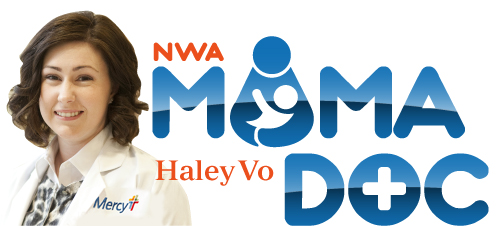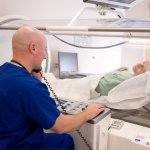
By Dr. Haley Vo, Mercy physician and mama of 3
We love springtime at my house. Unfortunately, with all the outdoor play comes the inevitable skinned knee and, sometimes, something worse. It’s important to keep some simple first aid supplies around so you’ll be prepared. The first thing that comes to my mind, though, isn’t actually a supply. It’s a phone number. Hang onto this one:
THE NUMBER TO POISON CONTROL: 800-222-1222.
Before I became a mom, I thought I’d be completely careful, and my children would never need this. Then reality struck. I’ve called the poison control number because my children have eaten mosquito coils, Vaseline, vitamins (my dear husband gave our oldest daughter a “childproof” bottle of vitamins to play with. Don’t get me started.), and, most recently, the clip on the toilet-bowl cleaner tablets. Yep. Gross.
This number is staffed by the UAMS College of Pharmacy, and these people are geniuses.
Speaking of poison control, we no longer recommend that you keep syrup of ipecac in your house. We don’t want you to force your child to vomit. If it burns on the way down, it may burn on the way back up as well.
In addition, they might aspirate, which is a fancy word that means what comes up might go back down the wrong tube and end up in your child’s lungs. If your child has swallowed something that serious, they need to get to the emergency room ASAP.
Gauze and Tape: In addition to band-aids, which are always being stolen from the box at my house, gauze and tape come in handy. As you know by now, cuts and scrapes don’t only happen in nice, neat, small squares. This allows you to cover a larger area or an irregularly sized one.
Soap and water: Yes, peroxide or alcohol will work, but more often than not, good old plain soap and water will do the trick. It doesn’t even have to be antibacterial. I try to wash most of our cuts and scrapes this way, unless I can’t catch the wounded, in which case I generally throw some peroxide in their general direction. (Then again, if I can’t catch them, they’re probably not that hurt.)
Triple antibiotic ointment: Neosporin, Bacitracin, whatever you like. Applying the first few days after a cut or scratch happens is a good idea. Twice a day will do the trick.
Hydrocortisone cream: We live in Arkansas. That means there are all kinds of bugs waiting to munch on you and your child. As soon as possible after a bite, apply this over-the-counter steroid cream. It will decrease the itching, redness and swelling. You can do it up to 4 times each day. Don’t apply it near the eyes or for longer than 1 week at a time.
Aloe gel: Please, please, PLEASE slather your children in sunscreen. Please. And please don’t set a bad example by tanning yourself. Please. No, you don’t need a base tan before going to the beach to keep from being burned. Trust me. I’m whiter than white, and I don’t burn at the beach. I love the beach. But I also love sunscreen.
However, accidents do happen, whether it was because your husband didn’t use enough sunscreen in the middle of your back or because your child tried to grab a cookie off a too-hot pan. That’s when the aloe gel will help you out.
Ibuprofen or Tylenol: Kids don’t get sick at 9 a.m. on Tuesdays. Keep these around for those sudden fevers. That way we won’t collide at 2 a.m. in the aisle of Walgreen’s in our jammies.
Also, if your little one gets hurt, and it’s not too urgent, you can give them a dose immediately as you’re heading to the doctor. That way, they can start having pain relief as soon as possible. Don’t worry — the ibuprofen or Tylenol won’t stop us from giving them more pain medicine if they need it.
Good decision making skills: Sometimes it’s hard to know if you need to take your child to the ER so here are some guidelines: If your child has a cut that will not stop bleeding after 15-30 minutes of constant pressure, they need to go to the ER. Of course, if the bleeding is severe, don’t wait 15 minutes!
Also, if the cut is deep, or is “split open” they may need stitches or glue. Scars after repairing wounds vary widely. As a rule, we try to use very tiny thread on the face to avoid scars as much as possible. There are also different suturing techniques, some of which result in less scarring. If the cut is straight and clean, it’s much easier to repair than one that is star-shaped. It’s probably true to say that all stitches cause scars, but some scars are so tiny and light that you can’t see them with the naked eye.
If they have an obvious deformity of a bone (meaning a crooked arm or leg, a finger that’s not in the right place, etc.), they need to go to the emergency room. With really little kids, it’s sometimes hard to tell what’s important. If your child won’t stop crying, or won’t walk on an injured leg, or won’t use an injured arm, they need to be examined.
If your child hits their head and passes out, they need to go to the emergency room ASAP! Vomiting after hitting the head, persistent headache, changes in vision, changes in personality, extreme sleepiness, or trouble walking or moving arms are all worrisome signs after a head injury, and your child needs to see a doctor.
I hope this helps, and remember, when in doubt, call your doctor. We really are here to help. 🙂
To visit with Dr. Vo in person, you can schedule an appointment with her by calling the Bella Vista Medical Center at 479-855-6165 or click HERE to read more about her. Beginning next Monday, April 16th, Dr. Vo will be in Mercy’s newest clinic, Mercy Clinic Primary Care Sugar Creek in Bella Vista. It’s located at 24 Sugar Creek Center and the phone number is 479-876-1414. Same day appointments will be available at the clinic.





